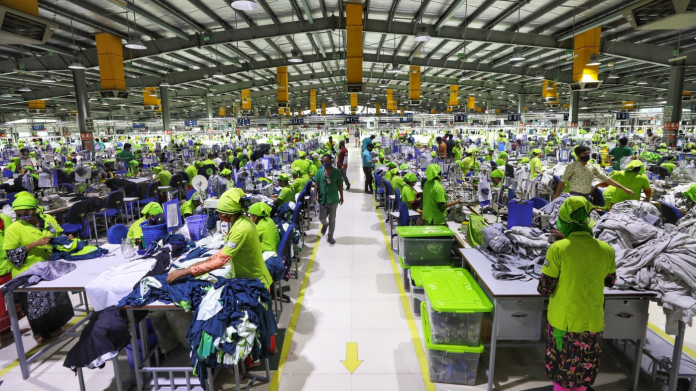In the heart of Bangladesh, the streets are filled with an unforeseen uproar that continues to resonate globally. Garment workers, the backbone of the country’s economy, find themselves cornered in a battle for their welfare, clashing with the powers in a series of ongoing protests.
The protests fuelled by the garment workers stem from longstanding issues of paltry wages and mistreatment sewn into the fabric of their laborious industry. These workers contribute to nearly 80% of the nation’s foreign income, yet they struggle for fair compensation and safe working conditions. This struggle refuses to fade into the background.
Unveiling the Turmoil of Bangladesh’s Garment Sector
The ongoing protests of garment workers in Bangladesh are a stark reminder of the aberrations in its thriving garment industry. Below, we explore why these protests are happening and investigate the underlying factors shaping the unsettling scenario.

Step 1: Understanding The Sparks of Discontent
The discontent among garment workers in Bangladesh were exacerbated by low wages, poor working conditions, and a lack of labour rights. The country’s garment industry, the world’s second-largest exporter of ready-made garments, has been facing unrest and picketing from disgruntled workers demanding a minimum wage hike and improving living conditions.
The living wage, the minimum income necessary for a worker to meet their basic needs – including food, housing, and other essential factors like healthcare – is a far cry from what most garment workers earn in Bangladesh. While the government announced a rise in the minimum wage in late 2018, the new stipulated wage still falls significantly short of the living wage.
Besides, working conditions in many garment factories are deplorable, with workers often toiling in cramped spaces, with little access to basic facilities, and under the constant pressure of meeting production quotas. This not only leads to physical strain and poor health but also takes a heavy toll on the mental well-being of these workers.
Furthermore, labour rights continue to be at stake. Many garment workers in Bangladesh are denied their rightful benefits and entitlements. There have been reported instances of biased treatment, harassment, and even the wrongful dismissal of workers associated with labour unions.
Step 2: The Catalyst – Wages and Workers’ Strikes
The issue of meagre wages served as the immediate catalyst for the protests. The garment workers’ ongoing protests in Bangladesh gathered steam when thousands of workers went on a strike, demanding a fair and livable wage. With wages not meeting the escalation of living costs in Bangladesh, workers find it difficult to survive, brewing discontent.
The strikes, primarily driven by the wage disparity, brought the country’s $30 billion garment industry to a literal standstill. Sewing machines fell silent, and shipments were delayed as workers took to the streets, voicing their demand for a decent wage hike. Their plea reverberated far and wide, grabbing international media attention.
On the other hand, the government and industry owners argue that increasing wages aggressively could potentially make the garment sector less competitive globally. They contend that buyers, especially from Western countries, are not ready to pay more than a set price threshold for the garments, pushing the industry into a cost-competitiveness bind.
However, workers dispute this rhetoric, pointing out the burgeoning profits of factory owners and the vast disparity in the distribution of these profits. They assert that owners can afford a justified wage hike, which would alleviate their economic distress and ensure emotional peace and job satisfaction, which are crucial for maintaining productivity levels.

Step 3: The International Dimension of the Protests
The garment workers’ ongoing protests in Bangladesh have elicited concern and peer pressure from the international community. Many renowned brands sourcing their products from Bangladesh have expressed their apprehensions regarding workers’ rights and have urged the Bangladeshi authorities to take corrective action.
Organizations like the Clean Clothes Campaign and Worker Rights Consortium have shown solidarity with the protesting workers, advocating for their rights, and initiating talks with international brands, factory owners, and government representatives to ameliorate the situation.
These international dimensions add substantial weight to the protests, making it a global concern rather than a local or national issue. The stakes are high, for the workers, obviously, but also for these international brands, who are under immense pressure to ensure their supply chains are ethically compliant.
It is important to note that while solidarity from international players is crucial, the protests’ resolution primarily rests on Bangladesh’s industry owners and government authorities. The international community’s role should ideally be of constructive engagement rather than imposing solutions.
Step 4: Seeking A Resolution – The Current State and The Path Ahead
Attempts at resolving the garment workers’ ongoing protests in Bangladesh have been made, albeit ineffective. These efforts broadly entail the government’s initiatives, factory owners’ responses, labour union negotiations, and the international community’s interventions. However, the challenge of reaching a consensus remains formidable.
The government has set up a wage board to review the workers’ demands, but the speed and scope of these undertakings have been subject to criticism. Factory owners have shown some willingness to re-negotiate wages, but the ground implementation remains inadequate. Moreover, labor union leaders are targeted and dismissed, further impeding the resolution process.
Unless stakeholders are genuinely driving to acknowledge the workers’ needs, the resolution seems unlikely in the near term. Yet, the path ahead definitely lies in open dialogues, collaboration among stakeholders, and honest efforts to improve workers’ conditions comprehensively.
Garment workers have been the backbone of Bangladesh’s economy for long. Their wellbeing is crucial, not only from a human rights perspective, but if Bangladesh is to sustain its position in the global apparel market. A fairer share of profits, better working conditions, and stronger labor rights may well be the necessary cost for its continued prosperity.
Step 5: Implications for the Future
The implications of the garment workers’ ongoing protests in Bangladesh for the country’s future are significant. For workers, their livelihood is more precarious than ever. They’re battling low wages and the fear of losing jobs to automation as more factories pivot towards technology.
For the country, the protests underscore the need to address labor issues to maintain their position as a leading garment manufacturer. A tarnished reputation can lead to reduced orders, impacting the economy heavily. Therefore, future growth is contingent on respecting and upholding workers’ rights and ensuring a fair share for everyone involved in the garment trade.
International brands must review their purchasing practices, pushing for fair trade rather than just low costs. They have a responsibility towards the workers who make their profits possible. Using their leverage, they can instigate meaningful change, ensuring a more equitable future for the garment sector.
The overall implications are clear: long-standing labor problems need immediate attention. The ongoing protests are not isolated incidents, but symptoms of systemic issues that need structural overhaul. It’s time to realize that garments made with dignity, fairness and respect hold more value.
True resolution of the garment workers’ ongoing protests in Bangladesh can only be achieved when all stakeholders accept their responsibilities and act upon them sincerely. This involves fair pay, improved working conditions, respect for labor rights, and above all, recognizing the workers’ contribution to the industry, the economy, and society.


Frequently Asked Questions
Many questions arise in the backdrop of the garment workers’ ongoing protests in Bangladesh. Here, we strive to answer some of the most commonly asked questions about the pressing issue.
1. Why are garment workers in Bangladesh protesting?
The garment workers in Bangladesh have been protesting primarily over low wages and inhumane working conditions. They demand a substantial increase in the minimum wage, which currently stands far below a living wage in the country, leaving them unable to meet their basic needs.
In addition, they also seek improvement in workplace safety. Bangladesh’s garment industry has a tragic history of accidents, mainly due to negligent management and weak government regulations. The workers want their rights recognized and workplace injustices rectified.
2. How is the garment industry crucial to Bangladesh’s economy?
The garment industry is key to Bangladesh’s economic health, accounting for nearly $30 billion in exports annually. It represents a crucial source of employment, employing over four million people, most of whom are women. This industry has significantly reduced poverty in Bangladesh, particularly for its female labor population.
However, the growing discontent among the garment workers and their protests could disrupt this crucial sector’s functioning. It could invite international scrutiny, adversely affecting exports and the overall economy.
3. What has been the impact of these protests so far?
The garment workers’ protests have started to raise international awareness regarding the plight of the workers in the Bangladeshi garment industry. It has brought to light the need for reform in wage structures and working conditions within the industry. Brands have begun to face pressure from consumers and international bodies to ensure the fair treatment of workers.
However, on the downside, the protests have led to the disruption of production in several factories, impacting not only the economy of the country but also the livelihood of the workers. The protests may also affect the global supply chain, given Bangladesh’s vital role in the global garment sector.
4. What role can international brands play to improve the situation?
International brands, as the main beneficiaries of Bangladesh’s garment industry, hold significant sway over the conditions of the factories. They can pressure the factories to improve working conditions and demand that wages be set at a level that ensures workers meet their basic needs. These brands can use their influence to demand better wage structures and working conditions.
Furthermore, international brands can also work on their supply chain transparency and ensure that their products are not made under exploitative conditions. They can hold their suppliers accountable and ensure compliance with fair trade and decent work norms.
5. Has the Bangladeshi government taken any steps to resolve the issue?
The government of Bangladesh has undertaken several measures to address the ongoing protests. Recognizing the problem’s immediacy, it has raised the minimum wage for garment workers. Despite this, the workers argue that the rise is insufficient, and so have continued with the protests.
In addition to this, the government has also launched initiatives to enhance workplace safety, albeit with limited success. The protests highlight the need for the government to take more decisive action. The sustenance of the country’s vital garment industry and the welfare of the workers are at stake.
Bangladesh police disperse protesting garment workers | WION Originals
The protests by Bangladeshi garment workers underline their struggle for fair wages and better working conditions. These ongoing actions reflect their determination to fight for their rights. The voices of these workers, vital to Bangladesh’s economy, urge for meaningful change in the industry.
The global community can’t ignore these protests either. Bangladesh is the world’s second-largest garment producer. Any changes here could echo globally and influence labor practices elsewhere. The world watches as Bangladesh’s garment workers dare to stand up for their worth.










